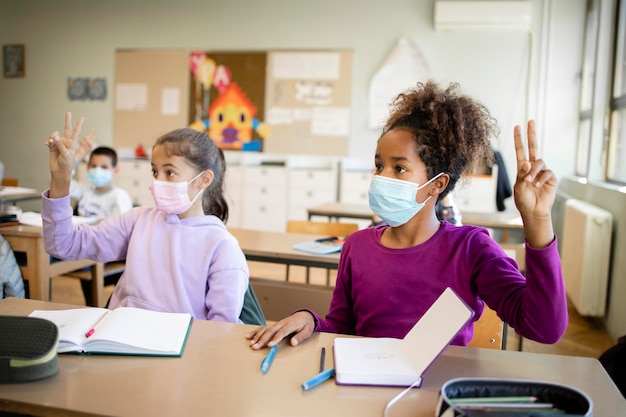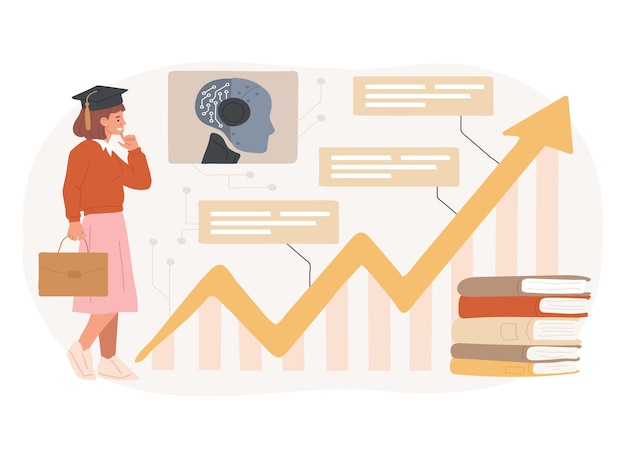Federal Initiatives: Addressing Learning Loss, Progress Report and Future Plans

Federal Initiatives to Address Learning Loss have been implemented to mitigate the impact of educational disruptions, with ongoing progress reports and future plans aiming to accelerate student recovery and address systemic inequities in education.
The **federal initiatives to address learning loss** represent a comprehensive response to the challenges faced by students nationwide. Let’s delve into the progress and future plans aimed at accelerating academic recovery and promoting educational equity.
Understanding Federal Initiatives to Combat Learning Loss
The COVID-19 pandemic significantly disrupted education across the United States, leading to widespread learning loss, particularly among vulnerable student populations. In response, the federal government has launched various initiatives to mitigate the impact of these disruptions and support student recovery. These initiatives aim to provide resources, guidance, and funding to states and local educational agencies (LEAs) to implement evidence-based strategies for addressing learning loss.
Understanding the scope and goals of these federal initiatives is crucial for educators, policymakers, and community members to effectively support student success. These initiatives represent a significant investment in the future of education and a commitment to ensuring that all students have the opportunity to thrive academically.
Key Federal Programs and Funding Streams
Several key federal programs and funding streams have been instrumental in addressing learning loss. These include:
- The Elementary and Secondary School Emergency Relief (ESSER) Fund: Provides substantial funding to states and LEAs to address the impact of the pandemic on schools and students.
- The American Rescue Plan (ARP): Allocates additional resources for education, including funding for summer learning programs, tutoring, and mental health support.
- Title I, Part A of the Elementary and Secondary Education Act (ESEA): Supports schools with high concentrations of students from low-income families, providing resources for academic interventions and support services.
These programs have enabled states and LEAs to implement a variety of strategies for addressing learning loss, including targeted interventions, extended learning time, and enhanced support for teachers and students.

The allocation of these funds varies across states and districts, depending on the specific needs and priorities of each community. However, the overarching goal remains the same: to provide targeted support to students who have experienced academic setbacks due to the pandemic.
In conclusion, these federal initiatives play a pivotal role in mitigating the impact of the pandemic. They also support students, providing them with the resources needed to recover academically and thrive in their educational journey.
Progress Report: Evaluating the Impact of Federal Initiatives
Evaluating the effectiveness of federal initiatives to address learning loss is essential for determining whether these programs are achieving their intended goals. While it is still early to draw definitive conclusions, initial progress reports offer valuable insights into the impact of these initiatives on student outcomes. These reports examine various indicators, including test scores, attendance rates, and student engagement, to assess the effectiveness of different interventions and strategies.
Progress reports also highlight the challenges and successes experienced by states and LEAs in implementing these initiatives. By sharing lessons learned and best practices, these reports contribute to a growing body of knowledge about how to effectively address learning loss and support student recovery.
Key Findings from Progress Reports
Initial progress reports suggest that some interventions, such as high-dosage tutoring and summer learning programs, have shown promising results in accelerating student learning. However, the impact of these interventions can vary depending on factors such as the quality of implementation, the intensity of the intervention, and the specific needs of the students being served.
- High-dosage tutoring: Provides individualized instruction to students in small groups or one-on-one settings.
- Summer learning programs: Offer extended learning opportunities during the summer months to help students catch up on missed content.
- Mental health support: Provides counseling and other mental health services to address the social and emotional needs of students.
Progress reports also underscore the importance of addressing systemic inequities in education. Students from low-income families and students of color have been disproportionately affected by learning loss, and targeted interventions are needed to close these achievement gaps.
Moreover, progress reports emphasize the need for ongoing monitoring and evaluation to ensure that these initiatives are achieving their intended outcomes. By collecting and analyzing data on student progress, educators and policymakers can refine their strategies and make informed decisions about how to allocate resources effectively.

Overall, the initial findings from progress reports offer a mixed picture of the impact of federal initiatives to address learning loss. While some interventions show promise, more work is needed to ensure that these programs are reaching all students who need them and that they are implemented effectively.
In conclusion, a thorough evaluation of progress reports is crucial for understanding the impact of these measures designed to counter learning losses. It helps ensure resources are allocated effectively and interventions are tailored to meet the unique needs of all students.
Strategies for Effective Implementation
Effective implementation of federal initiatives to address learning loss requires a comprehensive and coordinated approach that involves educators, policymakers, families, and community members. States and LEAs must develop clear plans for implementing these initiatives, taking into account the specific needs of their students and communities. These plans should be based on evidence-based practices and should include mechanisms for ongoing monitoring and evaluation.
Moreover, effective implementation requires strong leadership and collaboration at all levels. State and local leaders must work together to create a supportive environment for educators and to ensure that they have the resources and training they need to implement these initiatives effectively.
Key Strategies for Success
Several key strategies can help states and LEAs maximize the impact of federal initiatives to address learning loss. These include:
- Targeting interventions to the students who need them most: States and LEAs should use data to identify students who have experienced significant learning loss and to provide them with targeted interventions and support.
- Providing high-quality professional development for educators: Educators need to be trained in evidence-based practices for addressing learning loss and should receive ongoing support and coaching.
- Engaging families and communities: Families and community members can play a vital role in supporting student recovery. States and LEAs should involve them in the planning and implementation of these initiatives and should provide them with resources and information to help them support their children’s learning.
In addition to these strategies, it is essential to create a culture of continuous improvement. States and LEAs should regularly review their progress in addressing learning loss and should use data to inform their decisions about how to improve their strategies. They should also collaborate with researchers and experts to identify and implement the most effective interventions.
Effective planning is critical to ensuring resources reach those who need them and that interventions are as impactful as possible. By adopting these tactics, stakeholders can optimize the advantages of government initiatives and provide significant help to students needing support.
In summary, a well-organized strategy, including focused interventions, high-quality professional development, and robust community involvement, is essential for implementing these programs successfully and helping students overcome the challenges they encounter.
Addressing Equity Gaps in Learning Recovery
One of the most pressing challenges in addressing learning loss is the need to close equity gaps that have been exacerbated by the pandemic. Students from low-income families, students of color, and students with disabilities have been disproportionately affected by learning loss, and targeted interventions are needed to ensure that these students have the opportunity to catch up and succeed.
Addressing equity gaps requires a multifaceted approach that includes not only academic interventions but also efforts to address the social, emotional, and health needs of students. Schools must create a supportive and inclusive environment where all students feel valued and respected.
Strategies for Promoting Equity
Several strategies can help states and LEAs promote equity in learning recovery. These include:
- Providing targeted support to schools with high concentrations of students from low-income families: These schools often lack the resources and support they need to effectively address learning loss. States and LEAs should provide them with additional funding, staffing, and professional development.
- Implementing culturally responsive teaching practices: Culturally responsive teaching practices take into account the cultural backgrounds and experiences of students and use them to enhance learning.
- Addressing the social and emotional needs of students: Many students have experienced trauma and stress during the pandemic, and schools must provide them with mental health support and other resources to help them cope.
Additionally, states and LEAs should work to address systemic inequities that contribute to achievement gaps. This may include reforming school funding formulas, addressing inequities in access to high-quality teachers, and implementing policies that promote diversity and inclusion.
Here, it’s vital to address non-academic components, for example social, mental and health needs, and cultivate a supporting environment for all students so that they feel esteemed and valued. Therefore initiatives can deal with underlying problems, and make sure that every student has the chance to prosper.
To conclude, tending to unfairness that has been made worse because of the current health crisis is critical to make sure all students can catch up and achieve success.
Future Plans: Sustaining and Scaling Effective Interventions
Looking ahead, it is essential to sustain and scale up effective interventions that have shown promise in addressing learning loss. This requires a long-term commitment to investing in education and a willingness to adapt and innovate in response to evolving needs. States and LEAs should develop strategic plans for sustaining these initiatives beyond the period of federal funding and for scaling them up to reach more students.
Sustaining and scaling effective interventions also requires building capacity within the education system. This includes investing in professional development for educators, developing robust data systems, and fostering partnerships between schools, families, and community organizations.
Key Priorities for the Future
Several key priorities should guide future efforts to address learning loss. These include:
- Focusing on early literacy: Early literacy skills are foundational for future academic success. States and LEAs should prioritize interventions that support early literacy development, such as high-quality preschool programs and intensive reading interventions.
- Using technology to personalize learning: Technology can be a powerful tool for personalizing learning and providing students with individualized support. States and LEAs should invest in technology that can help educators differentiate instruction and track student progress.
- Building strong partnerships with families and communities: Families and community organizations can play a vital role in supporting student learning. States and LEAs should build strong partnerships with these stakeholders and should provide them with resources and information to help them support their children’s education.
Long-term commitment is necessary for carrying on and magnifying profitable intervention and it also needs constant adjustment, innovation and more support in the sector of learning. By supporting professional growth, enhancing data systems, and cultivating school-family-community alliances, the capacity in education can be built.
Ultimately, addressing learning loss requires a collective effort. By working together, educators, policymakers, families, and community members can create a brighter future for all students.
Policy Recommendations for Long-Term Impact
To ensure that federal initiatives to address learning loss have a lasting impact, policymakers must consider implementing policy reforms that address systemic inequities and support long-term student success. These reforms should focus on creating a more equitable and effective education system that meets the needs of all students, regardless of their background or circumstances.
Policy recommendations should be grounded in evidence-based practices and should be developed in collaboration with educators, researchers, and other stakeholders. They should also be designed to be flexible and adaptable, allowing states and LEAs to tailor them to their specific needs and contexts.
Key Policy Recommendations
Several key policy recommendations can help to ensure the long-term impact of federal initiatives to address learning loss. These include:
- Reforming school funding formulas: School funding formulas should be designed to provide equitable funding to all schools, regardless of their location or the socioeconomic status of their students.
- Addressing inequities in access to high-quality teachers: All students should have access to high-quality teachers who are well-trained and supported. States and LEAs should implement policies that attract and retain effective teachers, particularly in high-need schools.
- Expanding access to early childhood education: Early childhood education has been shown to have a lasting impact on student success. States and LEAs should expand access to high-quality preschool programs for all children, particularly those from low-income families.
In addition to these recommendations, policymakers should also consider implementing policies that promote innovation and experimentation in education. This includes providing funding for research and development, supporting the development of new educational models, and encouraging schools to experiment with new approaches to teaching and learning.
In summary, by implementing these policy recommendations, lawmakers can make sure government learning-loss mitigations have enduring repercussions. This leads to a higher quality education system, more equal, efficient and is more considerate with the needs of all students involved.
| Key Point | Brief Description |
|---|---|
| 📚 Federal Funding | ESSER and ARP funds supporting schools’ recovery. |
| 🍎 Effective Strategies | Tutoring, summer programs, and mental health support show promise. |
| 🎯 Equity Focus | Targeted support needed for disadvantaged students. |
| 🌱 Long-Term Policy | Equitable funding and high-quality teachers are key. |
FAQ Section
▼
The main initiatives include the Elementary and Secondary School Emergency Relief (ESSER) Fund and the American Rescue Plan (ARP), providing substantial funding for schools.
▼
High-dosage tutoring and summer learning programs have shown great promise in helping students catch up on missed content and improve their academic standing.
▼
Targeted interventions and support are being directed toward schools with high concentrations of low-income families to address disparities in learning recovery.
▼
Families are vital partners. States and LEAs should include them in planning and provide resources to support their children’s educational needs and academic growth.
▼
Reforms include equitable school funding, access to high-quality teachers, and expanded early childhood education to sustain progress in student achievement long-term.
Conclusion
In conclusion, the federal initiatives designed to address learning loss signify a pivotal response to the educational disruptions experienced across the United States. The ongoing progress reports and future plans underscore the commitment to not only mitigate the immediate impacts but also to foster long-term systemic improvements. By strategically implementing evidence-based practices and prioritizing equitable access to resources, these efforts aim to ensure that every student has the chance to succeed academically and reach their full potential.





